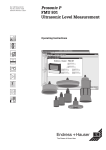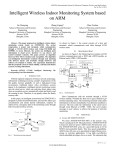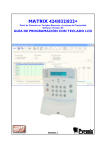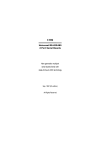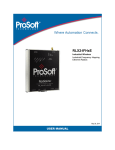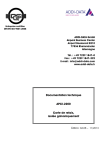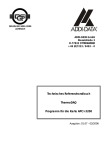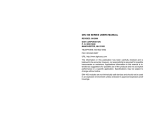Download ADDI-DATA APCI-7300-3
Transcript
Important information Communication boards APCI-7300-3 APCI-7420-3 APCI-7500-3 APCI-7800-3 Pin assignments RS232 module 01.03-05/2008 Addi-data GmbH · Airpark Business Center · Airport Boulevard B210 · 77836 Rheinmünster · Germany Phone +49 7229 1847-0 · Telefax +49 7229 1847-200 · info@ addi-data.com · www.addi-data.com Please observe that during the migration to RoHS-compliant boards, the pin assignment of RS232 changed. Thus, there are differences between the different revision numbers of the printed circuit board. Therefore please check your revision number. Thank you for your attention! Board Revision number Latest technical documentation APCI-7300-3 Rev. A-C See Rev. D, but with changed modem control signals DCD & DSR at RS232 modules. from Rev. D Internet: Manual download Edition: 02.03 – 03/2007-b (and later editions) Rev. A-B See Rev. C, but with changed modem control signals DCD & DSR at RS232 modules. from Rev. C Internet: Manual download Edition: 02.03 – 03/2007-b (and later editions) APCI-7420-3 APCI-7500-3 APCI-7800-3 APCI-7300-3, APCI-7420-3, APCI-7500-3 and APCI-7800-3: 9-pin SUB-D connector 9-pin SUB-D connector pin assignment with changed modem control signals DCD & DSR. APCI-7300-3, -7420-3, -7500-3: Rev. A-C APCI-7800-3: Rev. A-B Standard 9-pin SUB-D connector pin assignment APCI-7300-3, -7420-3, -7500-3: from Rev. D APCI-7800-3: from Rev. C Pin-No. Signal Pin-No. Signal 1 DSR 1 DCD 2 RXD 2 RXD 3 TXD 3 TXD 4 DTR 4 DTR 5 GND 5 GND 6 DCD 6 DSR 7 RTS 7 RTS 8 CTS 8 CTS 9 RI 9 RI www.addi-data.com APCI-7500-3: 37-pin SUB-D-connector 37-pin SUB-D connector pin assignment with changed modem control signals DCD & DSR. APCI-7500-3: Rev. A-C Pin-No. Standard 37-pin SUB-D connector pin assignment APCI-7500-3: from Rev. D Signal Pin-No. Signal 1, 10, 24, 33 DSR 1, 10, 24, 33 DCD 2, 11, 25, 34 RXD 2, 11, 25, 34 RXD 3, 12, 26, 35 TXD 3, 12, 26, 35 TXD 4, 13, 27, 36 DTR 4, 13, 27, 36 DTR 5, 14, 28, 37 GND 5, 14, 28, 37 GND 6, 15, 20, 29 DCD 6, 15, 20, 29 DSR APCI-7800-3: 78-pin SUB-D connector 78-pin SUB-D connector pin assignment Standard 78-pin SUB-D connector pin with changed modem control signals DCD assignment & DSR. APCI-7800-3: Rev. A-B Pin-No. 1, 6, 11, 16, 62, 67, 72, 77 APCI-7800-3: from Rev. C Signal Pin-No. Signal RI 1, 6, 11, 16, 62, 67, 72, 77 2, 7, 12, 17, 63, 68, 73, 78 DTR 2, 7, 12, 17, 63, 68, 73, 78 DTR 3, 8, 13, 18, 40, 64, 69, 74 GND 3, 8, 13, 18, 40, 64, 69, 74 GND 4, 9, 14, 20, 60, 65, 70, 75, TXD 4, 9, 14, 20, 60, 65, 70, 75, TXD 5, 10, 15, 19, 61, 66, 71, 76 RXD 5, 10, 15, 19, 61, 66, 71, 76 RXD 21, 23, 26, 31, 36, 48, 53, 58 DCD 21, 23, 26, 31, 36, 48, 53, 58 DSR 22, 27, 32, 37, 44, 49, 54, 59 DSR 22, 27, 32, 37, 44, 49, 54, 59 DCD 23, 28, 33, 38, 41, 45, 50, 55 CTS 23, 28, 33, 38, 41, 45, 50, 55 CTS 24, 29, 34, 39, 42, 46, 51, 56 RTS 24, 29, 34, 39, 42, 46, 51, 56 RTS www.addi-data.com RI Should you have questions that you do not find in the manual or on our website (http://www.addi-data.com), please contact us by phone or e-mail: [email protected] Addi-data GmbH · Airpark Business Center · Airport Boulevard B210 · 77836 Rheinmünster · Germany Phone +49 7229 1847-0 · Telefax +49 7229 1847-200 · [email protected] · www.addi-data.com DIN EN ISO 9001:2000 certified ADDI-DATA GmbH Airpark Business Center Airport Boulevard B210 77836 Rheinmünster Germany +49 7229 1847-0 Technical description APCI-7300-3, APCI-7420-3, APCI-7500-3(/4C), APCI-7800-3 1-port, 2-port, 4-port, 8-port serial interface for the PCI bus Edition: 02.05 - 12/2009 Product information This manual contains the technical installation and important instructions for correct commissioning and usage, as well as production information according to the current status before printing. The content of this manual and the technical product data may be changed without prior notice. ADDI-DATA GmbH reserves the right to make changes to the technical data and the materials included herein. Warranty and liability The user is not permitted to make changes to the product beyond the intended use, or to interfere with the product in any other way. ADDI-DATA shall not be liable for obvious printing and phrasing errors. In addition, ADDI DATA, if legally permissible, shall not be liable for personal injury or damage to materials caused by improper installation and/or commissioning of the board by the user or improper use, for example, if the board is operated despite faulty safety and protection devices, or if notes in the operating instructions regarding transport, storage, installation, commissioning, operation, thresholds, etc. are not taken into consideration. Liability is further excluded if the operator changes the board or the source code files without authorisation and/or if the operator is guilty of not monitoring the permanent operational capability of working parts and this has led to damage. Copyright This manual, which is intended for the operator and its staff only, is protected by copyright. Duplication of the information contained in the operating instructions and of any other product information, or disclosure of this information for use by third parties, is not permitted, unless this right has been granted by the product licence issued. Non-compliance with this could lead to civil and criminal proceedings. ADDI-DATA software product licence Please read this licence carefully before using the standard software. The customer is only granted the right to use this software if he/she agrees with the conditions of this licence. The software must only be used to set up the ADDI-DATA boards. Reproduction of the software is forbidden (except for back-up and for exchange of faulty data carriers). Disassembly, decompilation, decryption and reverse engineering of the software are forbidden. This licence and the software may be transferred to a third party if this party has acquired a board by purchase, has agreed to all the conditions in this licence contract and the original owner does not keep any copies of the software. Trademarks - ADDI-DATA is a registered trademark of ADDI-DATA GmbH. - Turbo Pascal, Delphi, Borland C, Borland C++ are registered trademarks of Borland Insight Company. - Microsoft C, Visual C++, Windows XP, 98, Windows 2000, Windows 95, Windows NT, EmbeddedNT and MS DOS are registered trademarks of Microsoft Corporation. - LabVIEW, LabWindows/CVI, DasyLab, Diadem are registered trademarks of National Instruments Corp. - CompactPCI is a registered trademark of PCI Industrial Computer Manufacturers Group. - VxWorks is a registered trademark of Wind River Systems Inc. WARNING The following risks result from improper implementation and from use of the board contrary to the regulations: ♦ Personal injury ♦ Damage to the board, PC and peripherals ♦ Pollution of the environment ♦ Protect yourself, the others and the environment! ♦ Read carefully the safety precautions (yellow leaflet). If this leaflet is not with the documentation, please contact us and ask for it. ♦ Observe the instructions of the manual. Make sure that you do not forget or skip any step. We are not liable for damages resulting from a wrong use of the board. ♦ i Used symbols: IMPORTANT! designates hints and other useful information. WARNING! It designates a possibly dangerous situation. If the instructions are ignored the board, PC and/or peripheral may be destroyed. 3 Contents APCI-7xxx-3 1 DEFINITION OF APPLICATION ............................... 8 1.1 Intended use ....................................................................8 1.2 Usage restrictions.............................................................8 1.3 General description of the board ....................................8 2 USER .................................................................. 11 2.1 Qualification ..................................................................11 2.2 Country-specific regulations .........................................11 3 HANDLING OF THE BOARD.................................. 12 4 TECHNICAL DATA ............................................... 13 4.1 Electromagnetic compatibility (EMC) ............................13 4.2 Physical set-up of the board ..........................................13 4.3 Limit values.....................................................................15 4.3.1 4.3.2 4.3.3 RS232.................................................................................. 16 RS422, RS485 ...................................................................... 16 20mA constant current loop (MXTTY)................................... 17 4.4 Component scheme and block diagrams.....................18 5 INSTALLATION OF THE BOARD ............................. 24 5.1 Opening the PC..............................................................24 5.2 Selecting a free slot .......................................................24 5.3 Plugging the board into the slot ....................................25 5.4 Closing the PC ...............................................................25 6 BOARD CONFIGURATION ................................... 26 6.1 Configuration under Windows XP/2000/95/98/ Server 2003 26 6.2 Board test .......................................................................30 6.3 Questions and software downloads on the web............31 7 CONNECTING THE PERIPHERAL........................... 32 7.1 Connector pin assignment: APCI-7500-3 ......................32 7.2 Pin assignment: APCI-7420-3, APCI-7300-3 and APCI-75003(/4C) 33 7.3 Pin assignment: APCI-7800-3.........................................34 7.4 Pin assignments (APCI-7500-3): RS422 with handshake signals 39 4 Contents APCI-7xxx-3 7.5 Pin assignments (APCI-7420-3 and APCI-7300-3): RS422 with handshake signals .....................................................................39 7.6 Connection cable – APCI-7500-3 ..................................40 7.7 Connection examples....................................................41 7.7.1 7.7.3 APCI-7500-3 ........................................................................ 41 RS232 cabling .....................................................................41 RS422 cabling .....................................................................41 RS485 cabling .....................................................................42 Current loop (20 mA) cabling ..............................................42 APCI-7300-3, APCI-7420-3, APCI-7500-3/4C ....................... 44 RS232 cabling .....................................................................44 RS422 cabling .....................................................................45 RS485 cabling .....................................................................45 Current loop (20 mA) cabling ..............................................46 APCI-7800-3 ........................................................................ 48 7.8 Connection examples....................................................49 7.8.1 7.8.2 7.8.3 7.8.4 RS232 cabling ..................................................................... 49 RS422 cabling ..................................................................... 50 RS485 cabling ..................................................................... 50 Current Loop (20 mA) cabling ............................................. 51 8 TESTING THE BOARD ........................................... 53 8.1 Connecting a shorting plug ...........................................53 8.2 Testing the board with the MTTTY program.....................55 7.7.2 RS422, RS232 and 20 mA Current Loop ..............................55 RS485 ..................................................................................57 9 REPLACING THE MODULES.................................. 58 9.1 Replacing the MX modules ............................................58 10 GLOSSARY.......................................................... 60 11 INDEX ................................................................ 63 5 APCI-7xxx-3 Figures and Tables Figures Fig. 3-1: Correct handling.........................................................................12 Fig. 4-1: Component scheme of the APCI-7300-3, APCI-7420-3 and APCI7500-3 .....................................................................................18 Fig. 4-2: Component scheme of the APCI-7800-3...................................19 Fig. 4-3: Component scheme of the APCI-7800-3 (solder side) ...............20 Fig. 4-4: Block diagram of the APCI-7300-3..............................................21 Fig. 4-5: Block diagram of the APCI-7420-3..............................................21 Fig. 4-6: Block diagram of the APCI-7500-3..............................................22 Fig. 4-7: Block diagram of the APCI-7500-3/4C........................................22 Fig. 4-8: Block diagram of the APCI-7800-3..............................................23 Fig. 5-1: Slot types.....................................................................................24 Fig. 5-2: Inserting the board......................................................................25 Fig. 5-3: Fastening the board at the back cover......................................25 Fig. 6-1: FIFO settings under Windows 2000 ..........................................27 Fig. 6-2: Setting example: RS485 ..........................................................28 Fig. 6-3: Setting example: MXTTY current loop: Module configuration ..29 Fig. 6-4: Setting example: MXTTY current loop: Input clock ...................30 Fig. 7-1: 37-pin SUB-D male connector (of the board)..............................32 Fig. 7-2: 9-pin SUB-D male connector ......................................................33 Fig. 7-3: 78-pin SUB-D female connector (of the board) ..........................34 Fig. 7-4: Connection cable ST074 (4 x 25-pin)..........................................40 Fig. 7-5: Connection cable ST075 (4 x 9-pin)............................................40 Fig. 7-6: RS232 cabling - 4-port interface .................................................41 Fig. 7-7: RS422 cabling - 4-port interface .................................................41 Fig. 7-8: RS485 cabling - 4-port interface .................................................42 Fig. 7-9: Active transmission/active reception 4-port serial interface ........42 Fig. 7-10: Active transmission/passive reception 4-port serial interface ....43 Fig. 7-11: Passive transmission/active reception 4-port serial interface ....43 Fig. 7-12: Passive transmission/passive reception 4-port serial interface ..44 Fig. 7-13: RS232 cabling - 9-pin connector..............................................44 Fig. 7-14: RS422 cabling - 9-pin connector..............................................45 Fig. 7-15: RS485 cabling - 9-pin connector..............................................45 Fig. 7-16: Active transmission/active reception 9-pin connector..............46 Fig. 7-17: Active transmission/passive reception 9-pin connector ............46 Fig. 7-18: Passive transmission/active reception 9-pin connector ............47 Fig. 7-19: Passive transmission/passive reception 9-pin connector ..........47 Fig. 7-20: Connection cable ST7809 (8 x 9 pin) ........................................48 Fig. 7-21: Connection cable ST7825 (8 x 25 pin) ......................................49 Fig. 7-22: RS232 cabling...........................................................................49 Fig. 7-23: RS422 cabling...........................................................................50 Fig. 7-24: RS485 cabling...........................................................................50 Fig. 7-25: Active transmission/active reception ........................................51 Fig. 7-26: Active transmission/passive reception ......................................51 Fig. 7-27: Active transmission/passive reception – 4-fold interface ..........52 Fig. 7-28: Passive transmission/passive reception .....................................52 Fig. 8-1: Connection of the shorting plug RS232 ......................................53 6 APCI-7xxx-3 Figures and Tables Fig. 8-2: Connection of the shorting plug RS422 ...................................... 53 Fig. 8-3: Connection of the shorting plug for 20 mA Current Loop – active transmission/passive reception................................................ 54 Fig. 8-4: Connection of the shorting plug for 20 mA current Loop – passive transmission / active reception................................................ 54 Fig. 8-5: The MTTTY program ..................................................................... 55 Fig. 8-6: Window: “Comm Status” ............................................................ 56 Fig. 8-7: Window: „Flow Control“............................................................... 56 Fig. 8-8: Window: „Flow Control Settings”.................................................. 56 Fig. 9-1: Removing the MX module ......................................................... 58 Fig. 9-2: Inserting the MX module............................................................. 59 Tables Table 1-1: Different communication operating modes .......................... 10 Table 7-1: Pin assignment of the 37-pin connector ................................. 34 Table 7-2: Pin assignment of the 9-pin connector ................................... 35 Table 7-3: Pin assignment of port 1 .......................................................... 36 Table 7-4: Pin assignment of port 2 ......................................................... 37 Table 7-5: Pin assignment of port 3 ......................................................... 37 Table 7-6: Pin assignment of port 4 ......................................................... 38 Table 7-7: Pin assignment of port 5 ......................................................... 38 Table 7-8: Pin assignment of port 6 .......................................................... 39 Table 7-9: Pin assignment of port 7 ......................................................... 39 Table 7-10: Pin assignment of port 8 ....................................................... 40 Table 7-11: Pin assignment of the 37-pin connector: RS422 with handshake signals................................................................... 41 Table 7-12: Pin assignment of the 9-pin connector: RS422 with handshake signals................................................................... 41 Table 10-1: Glossary................................................................................. 61 7 APCI-7xxx-3 Figures and Tables 1 DEFINITION OF APPLICATION 1.1 Intended use The board APCI-7xxx-3 1 must be inserted in a PC with PCI 5V/32 bit (PCI 3.3V/32 Bit) which is used as electrical equipment for measurement, control and laboratory pursuant to the norm EN 61010-1 (IEC 61010-1). The used personal computer (PC) must fulfil the requirements of IEC 60950-1 or EN 60950-1 and 55022 or IEC/CISPR 22 and EN 55024 or IEC/CISPR 24. The use of the board APCI-7xxx-3 in combination with external screw terminal panels requires correct installation according to IEC 60439-1 or EN 60439-1 (switch cabinet / switch box). 1.2 Usage restrictions The APCI-7xxx-3 board must not to be used as safety related part (SRP). The board must not be used for safety related functions, for example for emergency stop functions. The APCI-7xxx-3 board must not be used in potentially explosive atmospheres. The APCI-7xxx-3 board must not be used as electrical equipment according to the Low Voltage Directive 2006/95/EC. 1.3 General description of the board The board APCI-7xxx-3 provides the personal computer (PC) with 1-port, 2-port, 4-port or 8-port asynchronous serial interface for the communication with external devices: Board Interface APCI-7300-3 1-port APCI-7420-3 2-port APCI-7500-3, APCI-7500-3/4C 4-port APCI-7800-3 8-port The operating mode of the interface depends on the MX modules installed. 1 Common designation in the manual for the boards APCI-7300-3, APCI-7420-3, APCI-7500-3, APCI-7500-3/4C and APCI-7800-3 8 APCI-7xxx-3 Figures and Tables The board is to be connected to the peripheral through a shielded cable, which shielding should be grounded on both ends. Minimum specifications of the connection cable: - metallised plastic hoods - shielded cable - cable shield folded back and firmly screwed to the connector housing. The board supports serial communication through 1, 2 or 4 asynchronous serial ports. The use of the board depends on the following parameters (See table below). Table 1-1: Different communication operating modes Plug-in module 1 Transmission standard Maximum transmission rate 2 MX232 RS232 115 kbps Optical isolation no MX232-G 1 kV MX422 no MX422-G MX422-PEP (RTS/CTS as RS422) RS422 115 kbps MX485 RS485 TTY (20 mA current loop) 19.2 kbps - 30 m - 1.2 km no automatic transmitter control 1 kV automatic transmitter control 1 kV standby current on transmit and receive channel 115 kbps MX485-G MXTTY 1 kV Interface setting Distance between transmitter and receiver 3 1.2 km 1 km If the basic board APCI-7xxx-3 is used with optically isolated modules and non isolated modules, then the safety built by the creeping distance of 3.2 mm is not ensured for the non isolated modules. Check the shielding capacity of the PC housing and cable prior to putting the device into operation. The use of the board includes observing all advises given in this manual and in the safety leaflet. 1 MXxxx-G: MX232-G, for example, stands for a plug-in module with the RS232 standard. The -G suffix means that the module is optically isolated. The MXTTY module is always optically isolated. 2 Transfer rates > 115 kbps on the board xPCI-7xx0 are possible up to 1 Mbps by means of an equipment option. 3 The indicated maximum lengths apply to normal interface cables (shielded control lead, 0.14 mm²). The length is also limited by the number of users, impedance, line capacity and transfer rate. 9 APCI-7xxx-3 Figures and Tables Uses beyond these specifications are not allowed. The manufacturer is not liable for any damages which would result from the non-observance of this clause. Make sure that the board remains in the protective blister pack until it is used. For all operating modes, the signal lines are to be twisted in pairs with GND. Use exclusively connection cable with twisted pairs. The housing of the peripheral connector - is to be firmly screwed together with the shield of the cable. - is to assure a low-resistance connection (< 100 mΩ) between the shield and the housing of the PC. The shield of the cable is to be earthed on both ends. Do not remove or alter the identification numbers of the board. If you do, the guarantee expires. 10 APCI-7xxx-3 2 USER 2.1 Qualification Figures and Tables Only persons trained in electronics are entitled to perform the following works: - installation - use - maintenance 2.2 Country-specific regulations Consider the country-specific regulations about: - the prevention of accidents - electrical and mechanical installations - radio interference suppression 11 APCI-7xxx-3 3 Figures and Tables HANDLING OF THE BOARD Fig. 3-1: Correct handling 12 APCI-7xxx-3 Figures and Tables 4 TECHNICAL DATA 4.1 Electromagnetic compatibility (EMC) The board APCI-7xxx-3 complies with the European EMC directive. The tests were carried out by a certified EMC laboratory in accordance with the norm from the EN 61326 series (IEC 61326). The limit values as set out by the European EMC directive for an industrial environment are complied with. The respective EMC test report is available on request. 4.2 Physical set-up of the board The boards APCI-7500-3, APCI-4720-3 and APCI-7300-3 are assembled on a 4-layer printed circuit card. Dimensions: 151 mm 99 mm Weight: ...................................................... approx. 120 g Installation in: ........................................... 32/64-bit PCI slot (5 V and 3.3 V) Connection to the peripheral: APCI-7300-3: ........................................... 9-pin SUB-D male connector APCI-7420-3: ........................................... 2 x 9-pin male SUD-D male connector APCI-7500-3: ........................................... 37-pin SUB-D male connector APCI-7500-3/4C: ..................................... 4 x 9-pin SUB-D male connector with 2nd slot Connection cables for the APCI-7500-3 1 : ST074: 37-pin SUB-D female connector to 4 x 25-pin SUB-D male connector ST075: 37-pin SUB-D female connector to 4 x 9-pin SUB-D male connector WARNING! The supply lines must be installed safely against mechanical loads. 1 Not included in the standard delivery. 13 APCI-7xxx-3 Figures and Tables The board APCI-7800-3 is assembled on a 6-layer circuit. Dimensions: 175 mm 99 mm Weight: ..................................................... approx. 150 g Installation in: ........................................... 32/64-bit PCI slot (5 V and 3.3 V) Connection to the peripheral: 78-pin SUB-D female connector Connection cable for the APCI-7800-3 1 ST7809: 78-pin SUB-D male connector to 8 x 9 pin SUB-D male connector ST075: 78-pin SUB-D male connector to 8 x 25-pin SUB-D male connector WARNING! The supply lines must be installed safely against mechanical loads. 1 Not contained in the standard delivery. Please order separately. 14 APCI-7xxx-3 4.3 Figures and Tables Limit values Max. altitude: ............................................ 2000 m Operating temperature: .............................. 0 to 60°C Storage temperature: ................................. -25 to 70°C Relative humidity at indoor installation 50% at +40 °C 80% at +31 °C Minimum PC requirements: PCI BIOS from Version 1.0 Bus speed: ................................................. < 33 MHz Operating system: ..................................... Windows Vista (32-bit), XP, 2000, Linux Energy requirements: - Operating voltage of the PC: .................. 5 V ± 5% - Current consumption (without load): ...... typ. see table ± 10% + 5 V from PC APCI-7300-3 APCI-7400-3 APCI-7500-3 APCI-7800-3 160 mA 160 mA 160 mA 220 mA Add to this data the current consumption of the used modules according to the following table: MXxxx MXxxx-G RS 232 10 mA 86 mA RS 422 10 mA 46 mA RS 485 10 mA 58 mA 20 mA 75 mA - - 66 mA MX 422-PEP 1 1 With software handshake (RTS CTS version) 15 APCI-7xxx-3 Figures and Tables 4.3.1 RS232 CCITT-recommendation: ......................... V.24 US-Norm EIA: .......................................... RS 232 Without optical isolation (MX232) Max. transfer rate: ................................... 1 MBaud Transfer rate on request ........................... Up to 2.5 MBaud ESD protection ....................................... 15 kV With optical isolation (MX232-G) Max. transfer rate: ................................... 1 MBaud Transfer rate on request ........................... Up to 2.5 MBaud ESD protection ....................................... 15 kV Creeping distance: .................................. 3.2 mm Test voltage: ............................................ 1000 VAC Short-circuit protection 4.3.2 RS422, RS485 CCITT recommendation: .......................... V.11 US norm EIA: ........................................... RS422, RS485 Without optical isolation (MX422, MX485) Max. transfer rate: .................................... 1 MBaud Transfer rate on request ............................ Up to 2.5 MBaud ESD protection ........................................ 15 kV Transorb diodes With optical isolation (MX422-G, MX485-G) Max. transfer rate: ..................................... Transfer rate on request ............................. ESD protection ......................................... Creeping distance: .................................... Test voltage: .............................................. Short-circuit protection 1 Mbaud Up to 2.5 MBaud 15 kV 3.2 mm 1000 VAC 16 APCI-7xxx-3 Figures and Tables 4.3.3 20mA constant current loop (MXTTY) Max. Baud rate:....................................... 19.2 kBaud Transorb diodes: ..................................... 400 W Absorption power Creeping distance: .................................. 3.2 mm Test voltage: ............................................ 1000 VAC Load: ....................................................... 500 Ω Voltage reversal and short-circuit protection through transorb diodes i IMPORTANT! Basic board and 1MBd configuration (option): Please check that the quartz frequency is correctly set in ADDIREG or in the device manager of your operating system. See 6.1 for Windows XP/2000. The 1M Baud rate can only be programmed with the device drivers delivered with the board. 17 APCI-7xxx-3 4.4 Figures and Tables Component scheme and block diagrams Fig. 4-1: Component scheme of the APCI-7300-3, APCI-7420-3 and APCI-7500-3 18 APCI-7xxx-3 Figures and Tables Fig. 4-2: Component scheme of the APCI-7800-3 19 APCI-7xxx-3 Figures and Tables Fig. 4-3: Component scheme of the APCI-7800-3 (solder side) 20 APCI-7xxx-3 Figures and Tables Fig. 4-4: Block diagram of the APCI-7300-3 Fig. 4-5: Block diagram of the APCI-7420-3 21 APCI-7xxx-3 Figures and Tables Fig. 4-6: Block diagram of the APCI-7500-3 Fig. 4-7: Block diagram of the APCI-7500-3/4C 22 APCI-7xxx-3 Figures and Tables Fig. 4-8: Block diagram of the APCI-7800-3 23 APCI-7xxx-3 5 Figures and Tables INSTALLATION OF THE BOARD The interrupt lines and base address of the board are allocated by the BIOS of the PC system through software. No setting is then required before inserting the board. i 5.1 IMPORTANT! Do observe the safety precautions (yellow leaflet)! Opening the PC ♦ Switch off your PC and all the units connected to the PC ♦ Pull the PC mains plug from the socket. ♦ Open your PC as described in the manual of the PC manufacturer. 5.2 Selecting a free slot ♦ Insert the board in a free PCI-5 V or 3.3 V slot (32/64-bit). Fig. 5-1: Slot types ♦ Remove the back cover of the selected slot according to the instructions of the PC manufacturer. Keep the back cover. You will need it if you remove the board ♦ Discharge yourself from electrostatic charges. ♦ Take the board out of its protective pack. 24 APCI-7xxx-3 5.3 Figures and Tables Plugging the board into the slot ♦ Insert the board vertically into the chosen slot. Fig. 5-2: Inserting the board ♦ Fasten the board to the rear of the PC housing with the screw which was fixed on the back cover. Fig. 5-3: Fastening the board at the back cover ♦ Tighten all the loosen screws. 5.4 Closing the PC ♦ Close your PC as described in the manual of the PC manufacturer. 25 APCI-7xxx-3 6 Figures and Tables BOARD CONFIGURATION In this chapter you will find a description of the delivered software and its possible applications. i IMPORTANT! Further information for installing and uninstalling the different drivers is to be found in the delivered description "Installation instructions for the PCI and ISA bus". A link to the corresponding PDF file is available in the navigation pane (Bookmarks) of Acrobat Reader. The board is supplied with a driver CD-ROM (CD1) containing: - ADDICOM software samples with API function for the ADDI-DATA boards in 32-bits 6.1 Configuration under Windows XP/2000/95/98/ Server 2003 In the Windows device manager you can set the different interfaces according to your requirements through double click. Start the device manager of your operating system under Start/(Settings)/Control panel/System In the "FIFO" register the following settings are possible: 26 APCI-7xxx-3 Figures and Tables Fig. 6-1: FIFO settings under Windows 2000 ∗ PCI bus and device number Management of the transmitter and receiver buffer Data flow control Reset the standard settings ∗ The example shows the settings under Windows 2000 27 APCI-7xxx-3 Figures and Tables Under "Setting" you adapt the operating mode to the used interface. Fig. 6-2: Setting example: RS485 ∗ RS 485 echo enable: For the control of the receiver at RS485 half duplex communication: Checked :During sending of data of the board to the peripheral, the receiver of the board is released. Not checked : During sending of data of the board to the peripheral, the receiver of the board is blocked. ∗ The example shows the settings under Windows 2000 28 APCI-7xxx-3 Figures and Tables Fig. 6-3: Setting example: MXTTY current loop: Module configuration ∗ Current flows (send): Definition of the current flow in the transmitting current loop, i.e. the non-operative connection of the board APCI-7xxx-3 (sender) to the peripheral device (receiver) (no serial data flow): : Current flows Checked Not checked : No current flows ∗ Current flows (reception): Definition of the current flow in the receiving current loop, i.e. the non-operative connection of the board APCI-7xxx-3 (receiver) to the peripheral device (sender) (no data flow): : Current flows Checked Not checked : No current flows The example shows the settings under Windows 2000 29 APCI-7xxx-3 Figures and Tables Fig. 6-4: Setting example: MXTTY current loop: Input clock ∗ Input clock: Under ”Crystal frequency“ the frequency of the integrated quartz oscillator of the board is indicated. The standard PC quartz crystal frequency is 1.8432 MHz, so that the max. baud rate that can be set is 115200. 6.2 Board test You can test if you board is not correctly installed with a shorting plug and the test software MTTTY. The setup file for the test software MTTTY is supplied on the CD-ROM under CD/MMTTY. The program is described in chapter 7.7.3. ∗ The example shows the settings under Windows 2000 30 APCI-7xxx-3 6.3 Figures and Tables Questions and software downloads on the web Do not hesitate to e-mail us your questions. per e-mail: [email protected] Free downloads of standard software You can download the latest version of the software for the board APCI-7xxx-3 http://www.addi-data.com. i IMPORTANT! Before using the board or in case of malfunction during operation, check if there is an update of the product (technical description, driver). The current version can be found on the internet or contact us directly. 31 APCI-7xxx-3 7 CONNECTING THE PERIPHERAL i 7.1 Figures and Tables IMPORTANT! The connector pin assignments are valid for the boards APCI-7300-3, APCI-7420-3 and APCI-7500-3 from Revision D and for the APCI-7800-3 from Revision C of the printed circuit board. At revisions before the DCD/DSR modem control signals at RS232 are changed. Connector pin assignment: APCI-7500-3 Fig. 7-1: 37-pin SUB-D male connector (of the board) 32 APCI-7xxx-3 Figures and Tables Table 7-1: Pin assignment of the 37-pin connector RS485 RS422 Current Loop RS232 Pin RS232 Current Loop RS422 DCD RxD TxD DTR GND DSR RTS CTS RI DCD RxD TxD DTR GND DSR RTS CTS RI +XMIT-CL-DATA TA -XMIT-CL-DATA TB +RCV-CL-DATA RA RS485 Pin 120 Ω 100 Ω Tx/Rx- RB TA TB Tx/Rx+ RA Rab (1) GND GND 120 Ω 100 Ω Tx/Rx- RB TA TB Tx/Rx+ RA Rab (1) GND GND TA: TB: Rab: (1): 7.2 DSR RTS CTS RI DCD RxD TxD DTR GND GND DSR Tsource RTS Rsource CTS -RCV-CL-DATA RI +XMIT-CL-DATA DCD -XMIT-CL-DATA RxD +RCV-CL-DATA TxD DTR GND GND Tsource Rsource -RCV-CL-DATA +XMIT-CL-DATA -XMIT-CL-DATA +RCV-CL-DATA 20 21 22 23 24 25 26 27 28 29 30 31 32 33 34 35 36 37 1 2 3 4 5 6 7 8 9 10 11 12 13 14 15 16 17 18 19 Port 4 Tx/Rx+ Rab (1) GND GND 100 Ω 120 Ω GND Tsource Rsource -RCV-CL-DATA +XMIT-CL-DATA -XMIT-CL-DATA +RCV-CL-DATA Port 3 RB TA TB RA Tx/RxPort 2 Tx/Rx+ Rab (1) GND GND 100 Ω 120 Ω GND Tsource Rsource -RCV-CL-DATA Port 1 RB Tx422+ RA: Rx422+ Tx422RB: Rx422Connection to a terminal resistor Cable connection to 100 Ω/120 Ω terminates the RS422/RS485 lines with the 100 Ω/120 Ω resistor. Pin assignment: APCI-7420-3, APCI-7300-3 and APCI-7500-3(/4C) Fig. 7-2: 9-pin SUB-D male connector 33 Tx/Rx- APCI-7xxx-3 Figures and Tables Table 7-2: Pin assignment of the 9-pin connector RS485 120 Ω Tx/Rx- RS422 100 Ω RB TA: TB: Rab: (1): 7.3 Current Loop Tsource Rsource -RCV-CL-DATA RS232 DSR RTS CTS RI Pin 6 7 8 9 Pin 1 2 3 4 5 RS232 DCD RxD TxD DTR GND Current Loop +XMIT-CL-DATA -XMIT-CL-DATA +RCV-CL-DATA GND RS422 RS485 TA TB RA Tx/Rx+ Rab (1) GND GND Tx422+ RA: Rx422+ Tx422RB: Rx422Connection to a terminal resistor Cable connection to 100 Ω/120 Ω terminates the RS422/RS485 lines with the 100 Ω/120 Ω resistor. Pin assignment: APCI-7800-3 Fig. 7-3: 78-pin SUB-D female connector (of the board) 34 APCI-7xxx-3 Figures and Tables Table 7-3: Pin assignment of port 1 Pin RS 232 RS 422 20 TxD RA 19 RxD TB 18 RS 485 Tx / Rx + RS422PEP Current Loop Rx+ +RCV-CL-DATA Tx- -XMIT-CL-DATA GND GND GND 39 RTS RTS- Tsource 38 CTS RTS+ Rsource 59 DCD TA Tx+ +XMIT-CL-DATA 58 DSR 100 Ω 78 DTR Rab 77 RI RB 120 Ω CTS+ CTS- Tx / Rx - RX- -RCV-CL-DATA Table 7-4: Pin assignment of port 2 Pin RS 232 RS 422 75 TxD RA 76 RxD TB 57 - 74 RS 485 Tx / Rx + RS422PEP Current Loop Rx+ +RCV-CL-DATA Tx- -XMIT-CL-DATA GND GND GND 56 RTS RTS- Tsource 55 CTS RTS+ Rsource 37 DCD TA Tx+ +XMIT-CL-DATA 36 DSR 100 Ω 17 DTR Rab 16 RI RB 120 Ω CTS+ CTS- Tx / Rx - RX- -RCV-CL-DATA 35 APCI-7xxx-3 Figures and Tables Table 7-5: Pin assignment of port 3 Pin RS 232 RS 422 14 TxD RA 15 RxD TB 35 - 13 RS 485 Tx / Rx + RS422PEP Current Loop Rx+ +RCV-CL-DATA Tx- -XMIT-CL-DATA GND GND GND 34 RTS RTS- Tsource 33 CTS RTS+ Rsource 54 DCD TA Tx+ +XMIT-CL-DATA 53 DSR 100 Ω 73 DTR Rab 72 RI RB 120 Ω CTS+ CTS- Tx / Rx - RX- -RCV-CL-DATA Table 7-6: Pin assignment of port 4 Pin RS 232 RS 422 70 TxD RA 71 RxD TB 69 GND 52 - 51 RS 485 Tx / Rx + RS422PEP Current Loop Rx+ +RCV-CL-DATA Tx- -XMIT-CL-DATA GND GND RTS RTS- Tsource 50 CTS RTS+ Rsource 32 DCD TA Tx+ +XMIT-CL-DATA 31 DSR 100 Ω 12 DTR Rab 11 RI RB 120 Ω CTS+ CTS- Tx / Rx - RX- -RCV-CL-DATA 36 APCI-7xxx-3 Figures and Tables Table 7-7: Pin assignment of port 5 Pin RS 232 RS 422 9 TxD RA 10 RxD TB 8 GND 30 - 29 RS 485 Tx / Rx + RS422PEP Current Loop Rx+ +RCV-CL-DATA Tx- -XMIT-CL-DATA GND GND RTS RTS- Tsource 28 CTS RTS+ Rsource 49 DCD TA Tx+ +XMIT-CL-DATA 48 DSR 100 Ω 68 DTR Rab 67 RI RB 120 Ω CTS+ CTS- Tx / Rx - RX- -RCV-CL-DATA Table 7-8: Pin assignment of port 6 Pin RS 232 RS 422 65 TxD RA 66 RxD TB 64 GND 47 - 46 RS 485 Tx / Rx + RS422PEP Current Loop Rx+ +RCV-CL-DATA Tx- -XMIT-CL-DATA GND GND RTS RTS- Tsource 45 CTS RTS+ Rsource 27 DCD TA Tx+ +XMIT-CL-DATA 26 DSR 100 Ω 7 DTR Rab 6 RI RB 120 Ω CTS+ CTS- Tx / Rx - RX- -RCV-CL-DATA 37 APCI-7xxx-3 Figures and Tables Table 7-9: Pin assignment of port 7 Pin RS 232 RS 422 4 TxD RA 5 RxD TB 3 GND 25 - 24 RS 485 Tx / Rx + RS422PEP Current Loop Rx+ +RCV-CL-DATA Tx- -XMIT-CL-DATA GND GND RTS RTS- Tsource 23 CTS RTS+ Rsource 44 DCD TA Tx+ +XMIT-CL-DATA 43 DSR 100 Ω 63 DTR Rab 62 RI RB 120 Ω Tx / Rx - CTS+ CTS- CTS- RTS- -RCV-CL-DATA Table 7-10: Pin assignment of port 8 Pin RS 232 RS 422 RS 485 Current Loop 60 TxD RA 61 RxD TB 40 GND GND 42 RTS RTS- Tsource 41 CTS RTS+ Rsource 22 DCD TA Tx+ +XMIT-CL-DATA 21 DSR Rab CTS+ CTS+ 2 DTR 100 Ω 120 Ω CTS- 1 RI RB Tx / Rx - RX- TA: TB: Rab: (1): Tx / Rx + RS422PEP Rx+ +RCV-CL-DATA Tx- -XMIT-CL-DATA -RCV-CL-DATA Tx422+ RA: Rx422+ Tx422RB: Rx422Connection to the terminal resistor Cable connection to 100 Ω/120 Ω terminates the lines RS422/RS485 with the resistor 100 Ω/120 Ω. 38 APCI-7xxx-3 7.4 Figures and Tables Pin assignments (APCI-7500-3): RS422 with handshake signals With the module MX422-PEP you can use the modem control signals RTS and CTS. Table 7-11: Pin assignment of the 37-pin connector: RS422 with handshake signals RS422 RS422 Pin Pin Port 4 Port 3 Port 2 Port 1 7.5 IA CB CA RB TA TB RA IB GND IA CB CA RB TA TB RA IB GND 20 21 22 23 24 25 26 27 28 29 30 31 32 33 34 35 36 37 TA: TB: Tx422+ Tx422- RA: RB: Rx422+ Rx422- IA: IB: CTS+ CTS- CA: CB: RTS+ RTS- 1 2 3 4 5 6 7 8 9 10 11 12 13 14 15 16 17 18 19 TA TB RA IB GND IA CB CA RB TA TB RA IB GND IA CB CA RB Port 4 Port 3 Port 2 Port 1 Pin assignments (APCI-7420-3 and APCI-7300-3): RS422 with handshake signals Table 7-12: Pin assignment of the 9-pin connector: RS422 with handshake signals RS422 IA CB CA RB Pin 6 7 8 9 TA: TB: Tx422+ Tx422- RA: RB: Rx422+ Rx422- IA: IB: CTS+ CTS- CA: CB: RTS+ RTS- Pin 1 2 3 4 5 RS422 TA TB RA IB GND 39 APCI-7xxx-3 7.6 Figures and Tables Connection cable – APCI-7500-3 Fig. 7-4: Connection cable ST074 (4 x 25-pin) *1 *2 Resistor integrated on the MX module Cable connection to 100 Ω/120 Ω terminates the RS422/RS485 lines with 100 Ω/120 Ω resistor. (Wire bridges between pin 20 and 6) Fig. 7-5: Connection cable ST075 (4 x 9-pin) *1 *2 Resistor integrated on the MX module Cable connection to 100 Ω/120 Ω terminates the RS422/RS485 lines with 100 Ω/120 Ω resistor. (Wire bridges between pin 4 and pin 6). 40 APCI-7xxx-3 7.7 Figures and Tables Connection examples 7.7.1 APCI-7500-3 RS232 cabling Fig. 7-6: RS232 cabling - 4-port interface 1 If the modem control signals are not used, they must be bridged externally via a jumper. RS422 cabling Fig. 7-7: RS422 cabling - 4-port interface 41 APCI-7xxx-3 Figures and Tables RS485 cabling Fig. 7-8: RS485 cabling - 4-port interface Current loop (20 mA) cabling Active/passive: When a transmitter and a receiver communicate, one of them has to supply the necessary current. If the transmitter supplies the current, it is active. The receiver is passive. In reverse, if the receiver supplies the current, it is active. Fig. 7-9: Active transmission/active reception 4-port serial interface 42 APCI-7xxx-3 Figures and Tables Fig. 7-10: Active transmission/passive reception 4-port serial interface Fig. 7-11: Passive transmission/active reception 4-port serial interface 43 APCI-7xxx-3 Figures and Tables Fig. 7-12: Passive transmission/passive reception 4-port serial interface 7.7.2 APCI-7300-3, APCI-7420-3, APCI-7500-3/4C RS232 cabling Fig. 7-13: RS232 cabling - 9-pin connector 44 APCI-7xxx-3 Figures and Tables RS422 cabling Fig. 7-14: RS422 cabling - 9-pin connector RS485 cabling Fig. 7-15: RS485 cabling - 9-pin connector 45 APCI-7xxx-3 Figures and Tables Current loop (20 mA) cabling Fig. 7-16: Active transmission/active reception 9-pin connector Fig. 7-17: Active transmission/passive reception 9-pin connector 46 APCI-7xxx-3 Figures and Tables Fig. 7-18: Passive transmission/active reception 9-pin connector Fig. 7-19: Passive transmission/passive reception 9-pin connector 47 APCI-7xxx-3 Figures and Tables 7.7.3 APCI-7800-3 Fig. 7-20: Connection cable ST7809 (8 x 9 pin) 48 APCI-7xxx-3 Figures and Tables Fig. 7-21: Connection cable ST7825 (8 x 25 pin) 7.8 Connection examples 7.8.1 RS232 cabling Fig. 7-22: RS232 cabling 49 APCI-7xxx-3 Figures and Tables 1: If the modem control signals are not used, they must be bridged via a wire bridge. 7.8.2 RS422 cabling Fig. 7-23: RS422 cabling 7.8.3 RS485 cabling Fig. 7-24: RS485 cabling 50 APCI-7xxx-3 Figures and Tables 7.8.4 Current Loop (20 mA) cabling Active/passive: When a transmitter and a receiver communicate, one of them has to supply the necessary current. If the transmitter supplies the current, it is active. The receiver is passive. In reverse, if the receiver supplies the current, it is active. Fig. 7-25: Active transmission/active reception Fig. 7-26: Active transmission/passive reception 51 APCI-7xxx-3 Figures and Tables Fig. 7-27: Active transmission/passive reception – 4-fold interface Fig. 7-28: Passive transmission/passive reception 52 APCI-7xxx-3 Figures and Tables 8 TESTING THE BOARD 8.1 Connecting a shorting plug When using the shorting plug described below and the test program MTTTY you can carry out a self-test of the board. Please note the signal connection of the different ports through the 9-pin shorting plug for the test: The recipient will be switched on the transmitter. Fig. 8-1: Connection of the shorting plug RS232 Fig. 8-2: Connection of the shorting plug RS422 53 APCI-7xxx-3 Figures and Tables Fig. 8-3: Connection of the shorting plug for 20 mA Current Loop – active transmission/passive reception Fig. 8-4: Connection of the shorting plug for 20 mA current Loop – passive transmission / active reception 54 APCI-7xxx-3 8.2 Figures and Tables Testing the board with the MTTTY program RS422, RS232 and 20 mA Current Loop ♦ Install the program on your PC. The program is delivered on the CD 1 “ADDI-DATA Standard Drivers”. Under CD/MTTTY start the setup.exe file. The following window appears: Fig. 8-5: The MTTTY program ♦ Select the right COM interface under "Port". ♦ Connect it with "File/Connect". If the shorting plug is connected, each key stroke (= data transmission) must result in the corresponding key character displayed on the screen (= data reception). If the test is successfully carried out, the board works. Once the port is initialised the state of the "Modem Control Signals" can be read in Modem Status. If the RTS signal is set, the CTS state is displayed under Modem Status. For DTR the 3 other fields are set. 55 APCI-7xxx-3 Figures and Tables Your settings will be displayed in the lower part of the main menu of the MTTY-program (see figure above) under „Comm Status“ (see figure below). Fig. 8-6: Window: “Comm Status” You can configure the handshake of the modem control signals according to your application as follows: ♦ Click in the menu of the MTTY program on „TTY“ and select„Flow Control“ (see figure below). Fig. 8-7: Window: „Flow Control“ After this the window „Flow Control Settings“ appears (see figure below). ♦ Here you can do the required settings Fig. 8-8: Window: „Flow Control Settings” 56 APCI-7xxx-3 Figures and Tables Below on the right of the main window of the MTTTY-program there is a text field for error or status messages. RS485 i IMPORTANT! For the self-test of the RS485 mode a short plug is needed. This operating mode shall be set firstly via the device manager of Windows XP/2000. ♦ In the device manager of Windows XP/2000 select under Settings "RS485 ECHO enable" and confirm with "OK". Start MTTTY and check with key press if the interface works correctly. 57 APCI-7xxx-3 9 i 9.1 Figures and Tables REPLACING THE MODULES IMPORTANT! We advise you to send us the board if a module is to be replaced. If you wish to effect the replacement yourself, consider the following: Observe the possible combinations according to the intended purpose of the board. Do observe the Safety precautions. Insert/remove the module carefully according to the following illustrations. Replacing the MX modules Fig. 9-1: Removing the MX module 58 APCI-7xxx-3 Figures and Tables Fig. 9-2: Inserting the MX module 59 APCI-7xxx-3 10 Figures and Tables GLOSSARY Table 10-1: Glossary Term A/D converter Acquisition Baud rate D/A converter Data acquisition DC voltage Disturb signal Driver Duplex Gain Ground Half duplex Handshaking Impedance Inductive loads Input impedance Limit value Low-pass filter MUX Noise immunity Description = ADC An electronic device that produces a digital output directly proportional to an analog signal output. The process by which data is gathered by the computer for analysis or storage. Serial communications data transmission rate; usually the number of bits-per-second. = DAC A device that converts digital information into a corresponding analog voltage or current. Gathering information from sources such as sensors and transducers in an accurate, timely and organized manner. Modern systems convert this information to digital data which can be stored and processed by a computer. = Direct current voltage DC voltage means that the voltage is constant respecting the time. It will always fluctuate slightly. Especially at switching on and switching off the transition behaviour is of high significance. Interferences that occur during the transfer caused by reduced bandwidth, attenuation, gain, noise, delay time etc. A part of the software that is used to control a specific hardware device such as a data acquisition board or a printer. The ability to both send and receive data simultaneously over the same communications line The factor by which an incoming signal is multiplied. A common reference point for an electrical system. Transmission in either direction, but not simultaneous Exchange of predetermined signals between two devices establishing a connection. Usually part of a communications protocol The reciprocal of admittance. Admittance is the complex ratio of the voltage across divided by the current flowing through a device, circuit element, or network. The voltage over the inductor is U=L.(dI/dt), whereas L is the inductivity and I is the current. If the current is switched on fast, the voltage over the load can become very highly for a short time. The measured resistance and capacitance between the high and low inputs of a circuit. Exceeding the limit values, even for just a short time, can lead to the destruction or to a loss of functionality. Transmitting all frequencies below a certain value = Multiplexer An array of semiconductor or electromechanical switches with a common output used for selecting one of a number of input signals. Noise immunity is the ability of a device to work during an electromagnetic interference without reduced functions. 60 APCI-7xxx-3 Noise suppression Operating voltage Optical isolation Output voltage Parameter PCI bus Protective circuitry Protective diode Resolution RS… RS232 RS422 RS485 RTD Figures and Tables The suppression of undesirable electrical interferences to a signal. Sources of noise include the ac power line, motors, generators, transformers, fluorescent lights, CRT displays, computers, electrical storms, welders, radio transmitters, and others. The operating voltage is the voltage that occurs during the continuous operation of the device. It may not exceed the continuous limit voltage. Furthermore, any negative operation situations, such as net overvoltages over one minute at switching on the device must be taken in consideration. The technique of using an optoelectric transmitter and receiver to transfer data without electrical continuity, to eliminate high-potential differences and transients. The nominal voltage output reading when shaft is rotated to full range, expressed in volts DC /Vo DC) The parameters of a control comprise all fort he control process required numeric values, e.g. for limit values and technological number. PCI bus is a fast local bus with a clock rate up to 33 MHz. This bus is used for processing a great number of data. The PCI bus is not limited like the ISA and EISA systems. A protective circuitry of the active part is done in order to protect the control electronic. The simplest protective circuitry is the parallel switching of a resistance. At the input of the integrated MOS (Metal Oxide Semi-Conductor)circuits used diodes, which operate at the permitted input voltages in the reverse range, but at overvoltage in the transition range and therefore protects the circuits against damage. The smallest significant number to which a measurement can be determined. For example a converter with 12-bit resolution can resolve 1 part in 4096. = Recommended standard number A serial asynchronous communications standard used to connect modems, terminals and printers with serial interfaces. Electrical characteristics of balanced-voltage digital interface circuits. Maximum connection distance of 4000 feet. The recommended standard of the Electronic Industry Association that specifies the electrical characteristics of drivers and receivers for use in balanced digital multipoint systems. = Resistance temperature detector An electrical circuit element characterized by a positive coefficient for resistivity. Sensor A device that responds to physical stimuli (heat, light, sound, pressure, motion, etc.) and produces a corresponding electrical output. Settling time The time required, after application of a step input signal, for the output voltage to settle and remain within a specified error band around the final value. The settling time of a system includes that of all of the components of the system. A short circuit of two clamps of an electric switch is when the Short circuit 61 APCI-7xxx-3 Short circuit current Synchronous Timer Figures and Tables concerning clamp voltage is zero. Short circuit current is the current between tow short-circuited clamps. In hardware, it is an event that occurs in a fixed time relationship to another event. In software, it refers to a function that begins an operation and returns to the calling program only when the operation is complete. The timer allows the adaptation of program processes between processor and peripheral devices. It usually contains from each other independent counters and can be programmed for several operation types over a control word register. 62 APCI-7xxx-3 11 Figures and Tables INDEX B Block diagrams 21 Board configuration 26 Board test 30 L Limit values 15 M C Component scheme APCI-7300, APCI-7420-3, APCI-500-3 18 APCI-7800-3 19 Configuration under Windows XP/2000 26 Connection cable APCI-7500-3 40 APCI-7800-3 48 Connection examples 41 Connector pin assignment APCI-7420-3, APCI-7300-3, APCI-75003/4C 33 APCI-7500-3 32 Current loop Cabling APCI-7300-3, APCI-74203. APCI7500-3/4C 46 Cabling APCI-7500-3 42 Connection of shorting plug 54 Limit values 17 Current Loop APCI-7800-3 51 D Dimensions 13 E EMC Electromagnetic compatibility 13 Energy requirements 15 F MTTTY program 55 MX module Inserting 59 Removing 58 P Physical set-up 13 Pin assignment APCI-7800-3 34 R Replacing the modules 58 RS232 Cabling APCI-7300-3, APCI-7420-3, APCI7500-3/4C 44 Cabling APCI-7500-3 41 Cabling APCI-7800-3 49 Connection of a shorting plug 53 Limit values 16 RS422 Cabling APCI-7300-3, APCI-7420-3, APCI7500-3/4C 45 Cabling APCI-7500-3 41 Cabling APCI-7800-3 50 Connection of a shorting plug 53 RS422, RS485 Limit values 16 RS485 Cabling APCI-7300-3, APCI-7420-3, APCI7500-3/4C 45 Cabling APCI-7500-3 42 Cabling APCI-7800-3 50 S FIFO settings under Windows 2000 27 G Slot types 24 Software download 31 Glossary 60 T H Handling of the board 12 I Installation of the board 24 Intended use 8 Internet 31 Technical data 13 Testing the board 53 Testing the board with MTTTY 55 U Update 31 Usage restrictions 8 User Personal protection 11 Qualification 11 63



































































